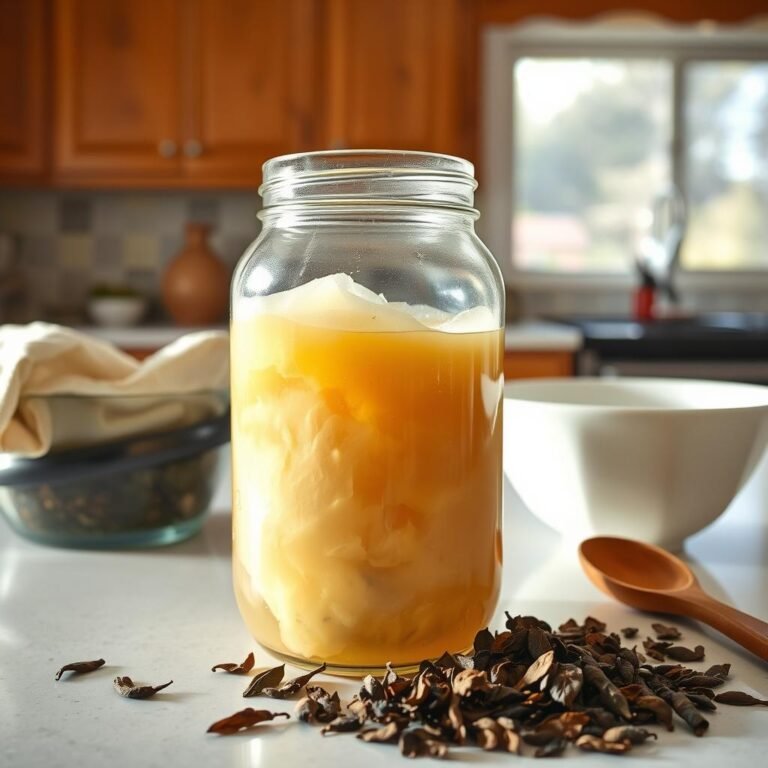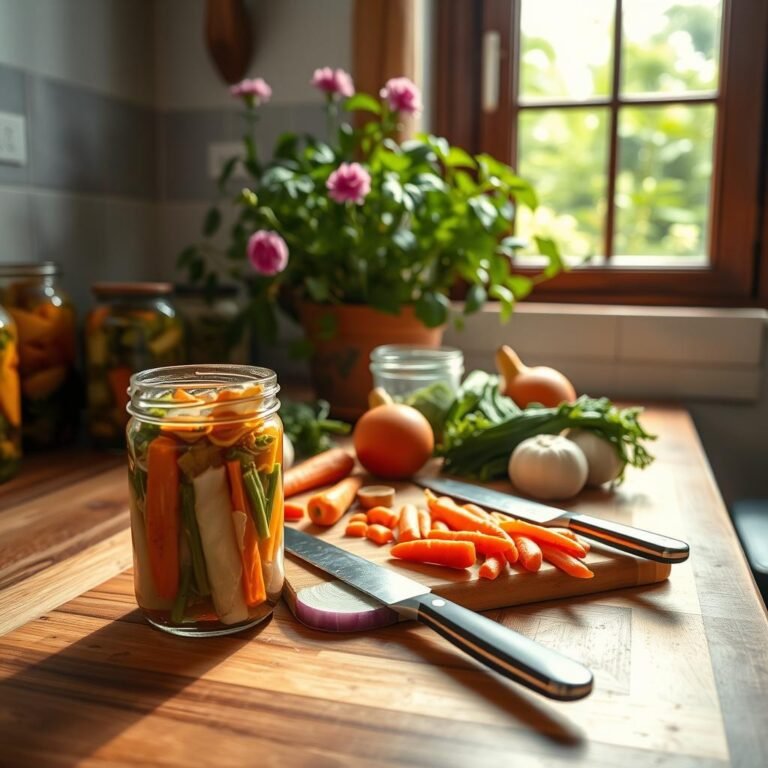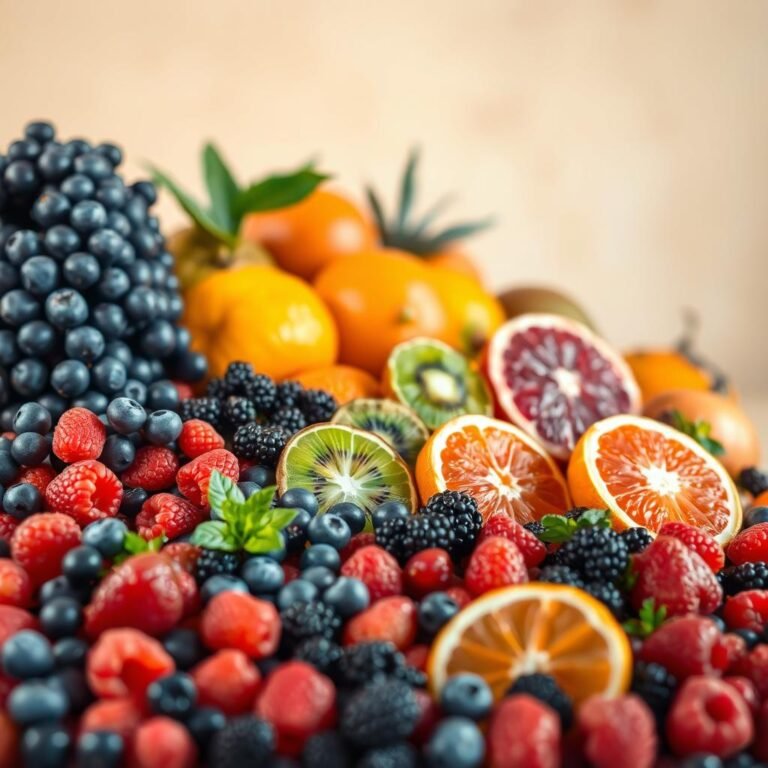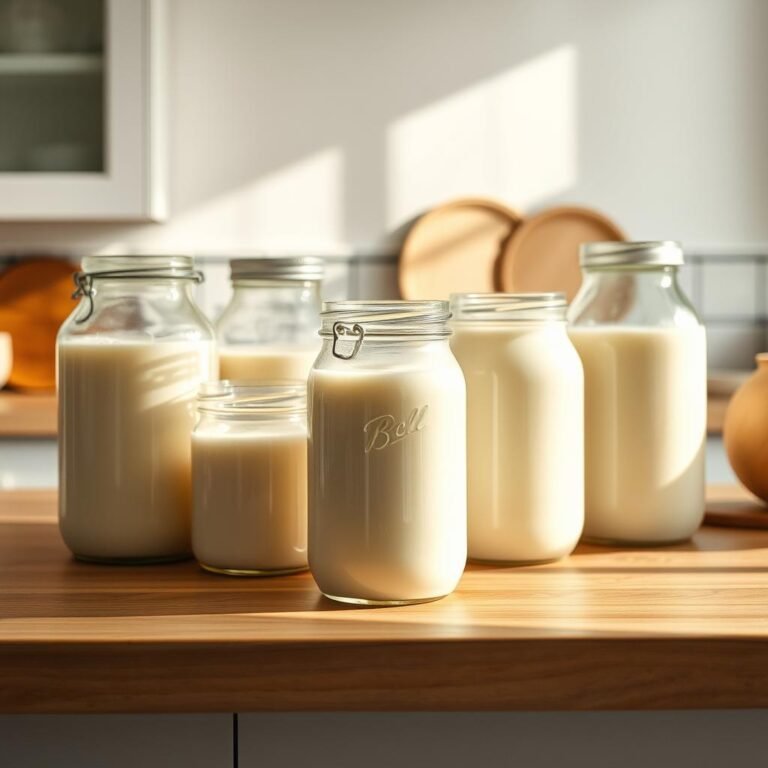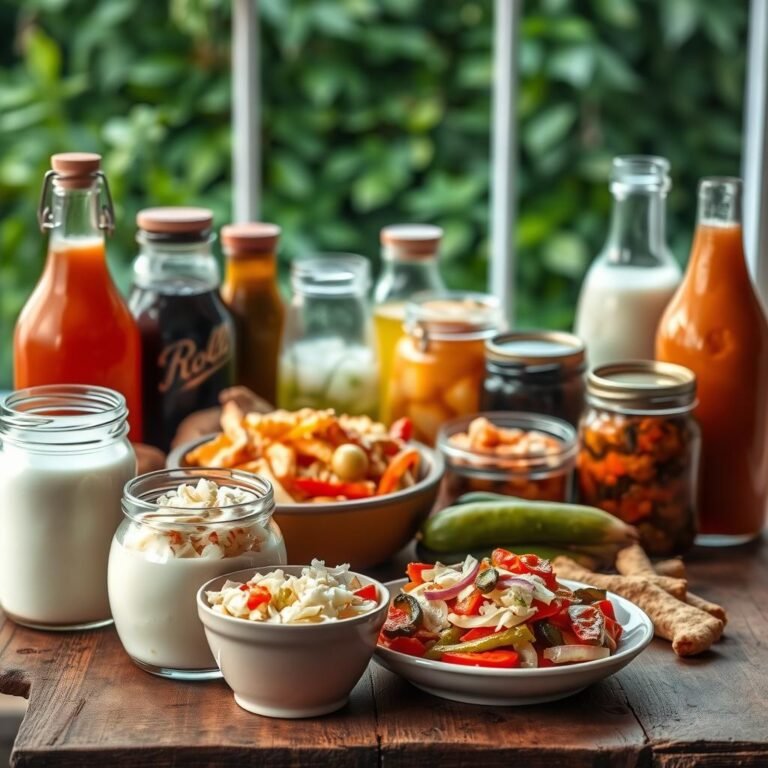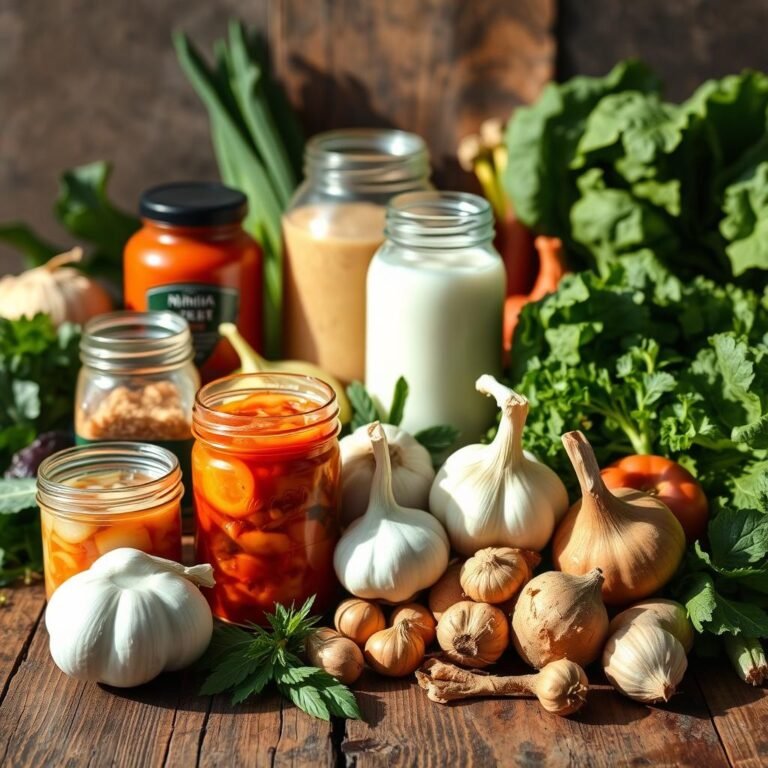How to Make Fermented Carrots for Probiotic Benefits
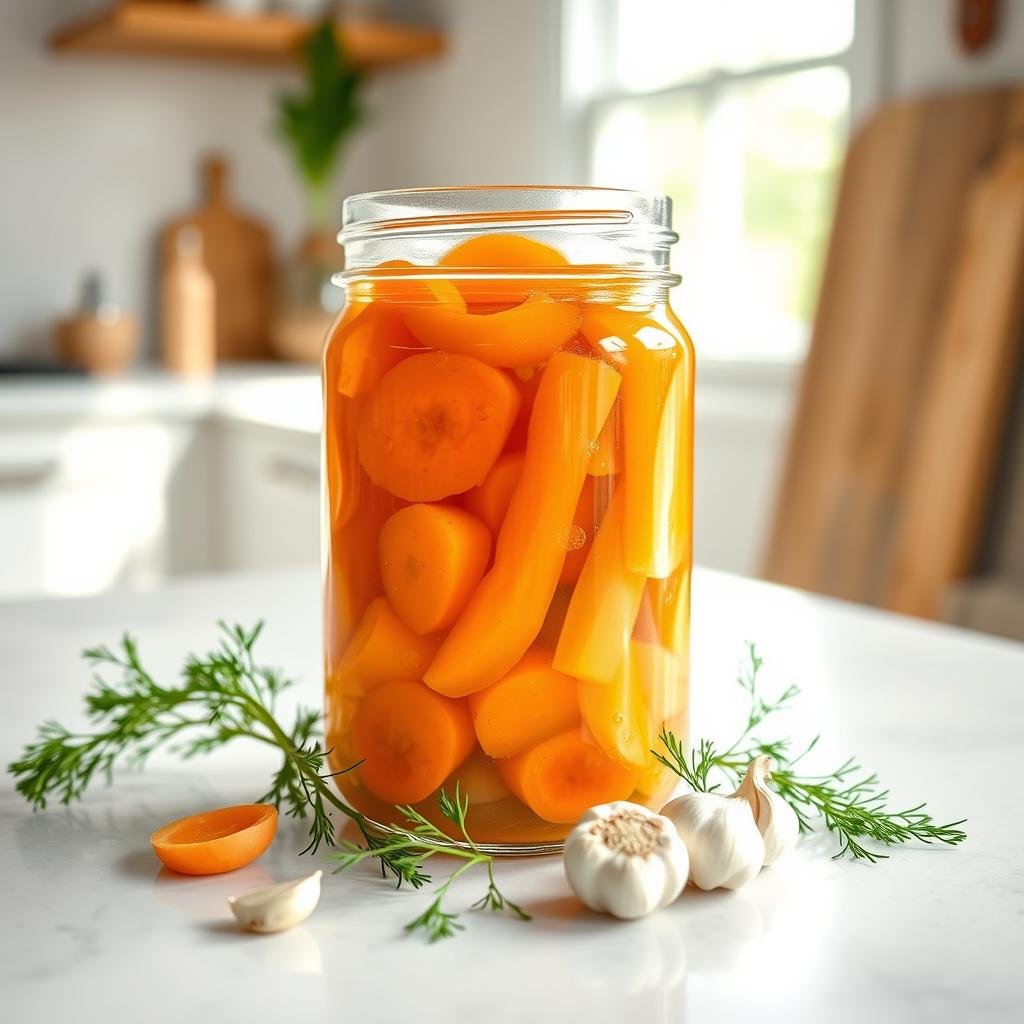
Learning how to make fermented carrots is rewarding. It makes your food taste better and boosts your health with probiotic carrots. This method uses salt, water, and veggies to grow good bacteria. These bacteria turn the carrots’ sugars into lactic acid, making them tangy and healthy.
Start by mixing salt in filtered water. This is key to stop chlorine from stopping the fermentation. Put your carrot sticks in a clean mason jar and cover them with the brine. Make sure the carrots are fully covered, using a fermenting weight if needed.
Leave the jar in a cool, quiet place for a few days. This lets the good bacteria do their work.
For more details, check out this guide. Keep the carrots in the fridge after they’re fermented. This keeps them fresh and their probiotic benefits. Adding lacto fermented carrots to your meals makes them tasty and good for your gut.
Why Choose Carrots for Fermentation?
Carrots are great for fermentation because they have natural sugars. These sugars help the fermentation process move faster. They also add probiotics and enzymes to your diet.
Fermented carrots are good for your gut. They support a strong immune system and healthy digestion.
Carrots are easy to find and not expensive. They’re perfect for beginners in fermentation. They taste great and are good for everyone, even kids.
Making fermented carrots is simple. You just need warm water, sea salt, and carrots. You can add garlic or herbs for extra flavor. They’re great with dips like ranch, guacamole, or hummus.
So, why choose carrots for fermentation? They’re healthy and easy to make. They’re a great choice for anyone new to fermented veggies.
Ingredients Needed for Fermented Carrots
To make tasty and healthy fermented carrots, you need the right stuff. Let’s look at what you’ll need to make the best fermented carrots.
Fresh Carrots: Choosing the Right Type
Choosing fresh carrots is key. They should be organic, bright, and firm. These carrots give your recipe the nutrients and flavor it needs.
Salt and Its Importance in Fermentation
Non-iodized salt is important for fermentation. It stops bad bacteria and helps good bacteria grow. The right salt makes your carrots taste great and stay healthy.
Optional Flavor Additions
You can add garlic, dill, or spices to your carrots. These extras make your carrots taste better and let you try new things. Find the mix that you like best.
| Ingredient | Purpose |
|---|---|
| Fresh Carrots | Base ingredient for texture and nutrients |
| Non-Iodized Salt | Promotes beneficial bacteria growth |
| Flavor Additions (Garlic, Dill, Spices) | Enhance taste and personalization |
Preparing Carrots for Fermentation
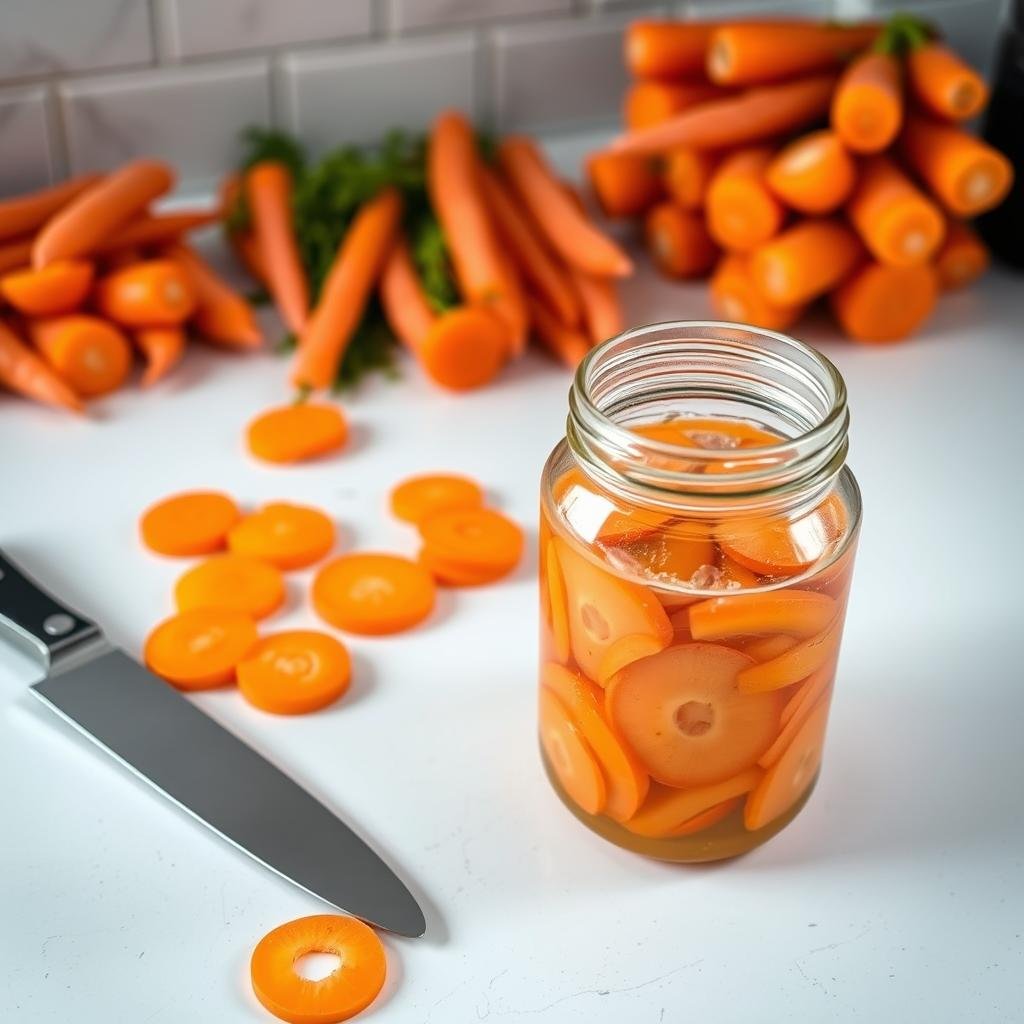
Getting ready to ferment carrots needs careful steps. These steps help make tasty, healthy food. Let’s look at how to prepare carrots for fermentation.
Washing and Peeling Carrots
Washing and peeling carrots is key. Washing gets rid of dirt and bad stuff. Peeling removes the outer layer, too. Use a brush to clean carrots well.
Cutting Carrots into Suitable Sizes
Cutting carrots into sticks is important. Small pieces ferment faster but get soft. Big pieces stay crunchy but take longer to ferment. Cut carrots into sticks that fit in a jar, leaving space at the top.
For more tips, check out this easy fermented carrots preparation guide.
Fermentation Methods
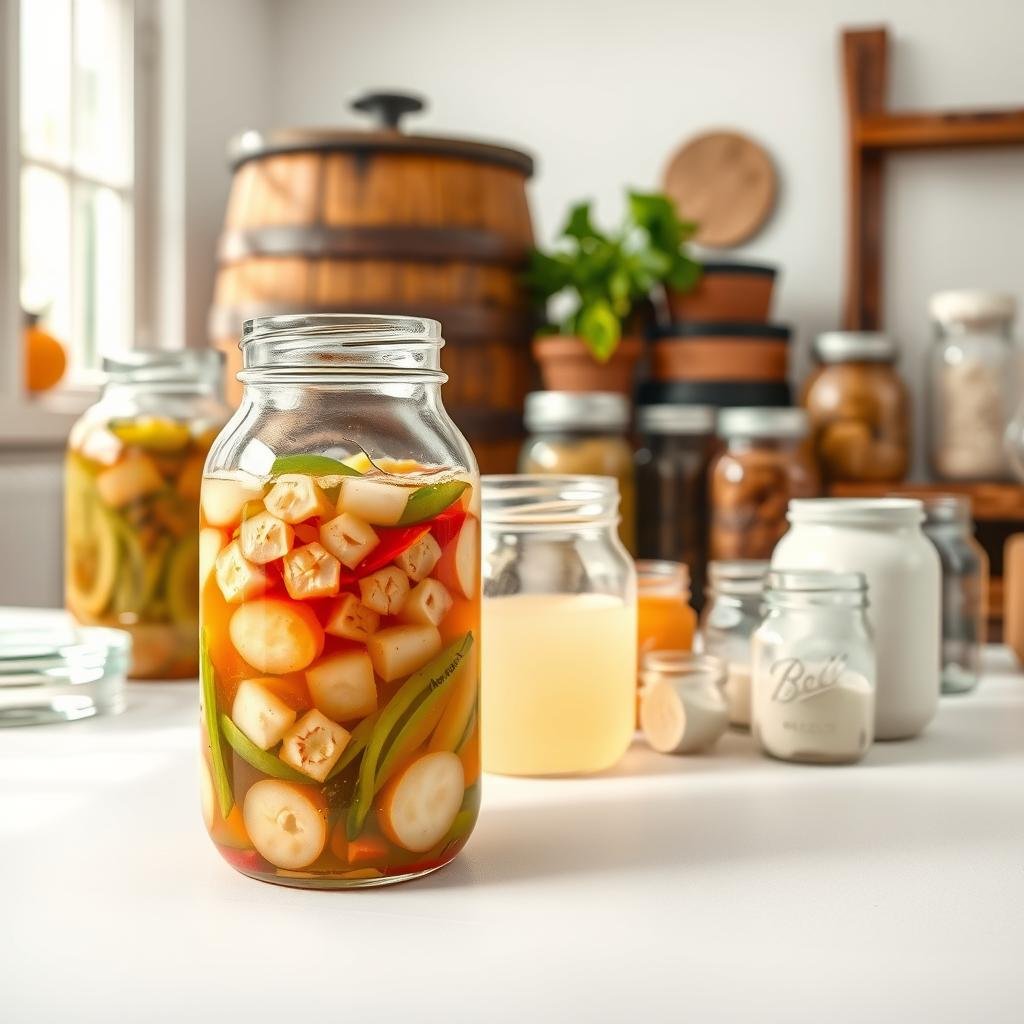
There are many ways to ferment carrots, each with its own benefits. Knowing these methods helps you pick the best one for you.
Traditional Jar Method
The traditional jar method is great for beginners. It’s simple and doesn’t need special tools. You just need jars with tight lids. It’s perfect for making small batches at home.
Using a Fermentation Crock
A fermentation crock offers a controlled space for fermenting. These crocks have features like water seals. They help keep the environment right for fermentation. This method is good for those who ferment often.
Quick Fermentation with the Refrigerator Method
The quick fermentation method is fast. It uses the fridge to speed up the process. This way, you get crunchy, probiotic-rich carrots quickly. It’s great for people who are short on time.
Adding Flavor to Fermented Carrots
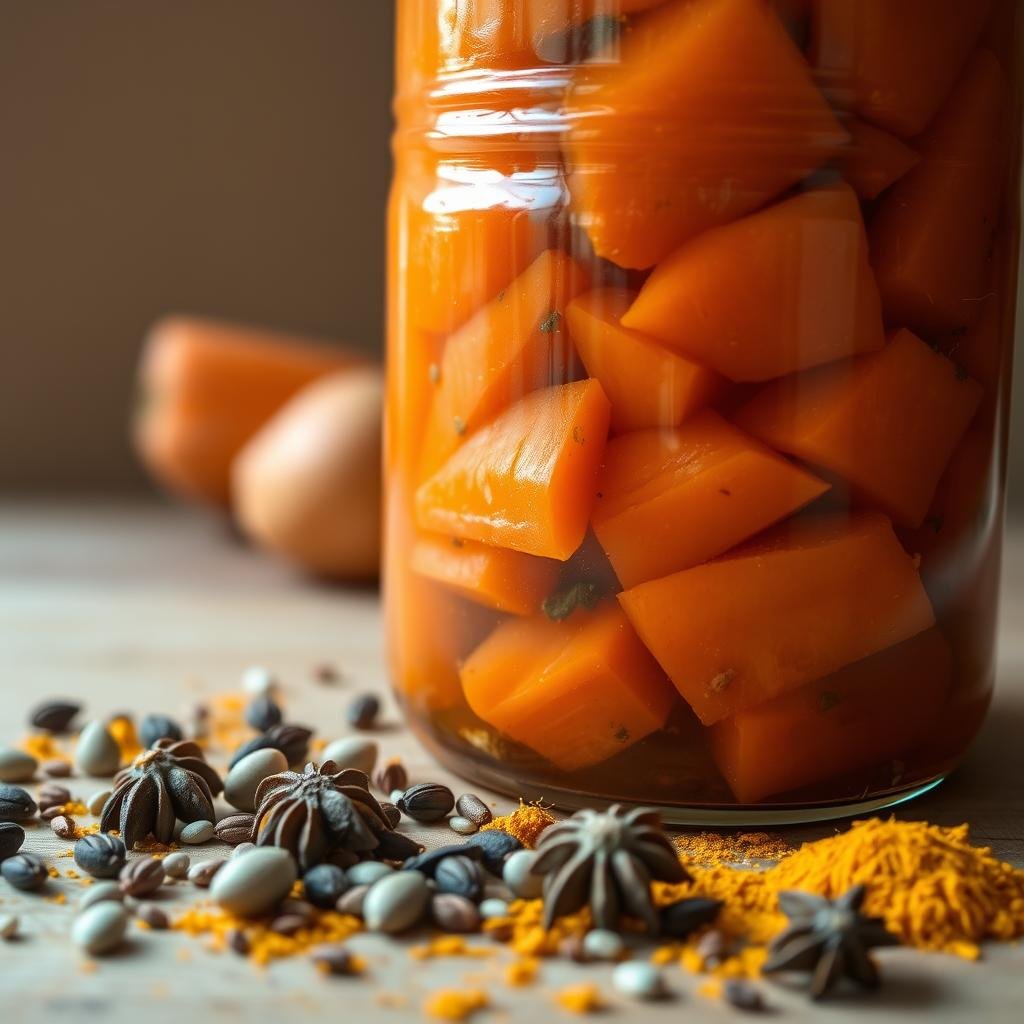
Adding flavor to fermented carrots can make a simple dish exciting. You can use herbs, spices, and other vegetables to do this. This way, you get new tastes and health benefits.
Herbs and Spices for Enhanced Taste
Using herbs and spices can make fermented carrots taste better. Dill, rosemary, and peppercorns add fresh and aromatic flavors. These spices also add health benefits.
Integrating Other Vegetables
Adding other vegetables to ferment with carrots is a great idea. Onions, peppers, or garlic can make the taste deeper and healthier. This mix creates a tasty dish full of probiotics.
Sweet vs. Savory Flavor Profiles
Finding the right mix of sweet and savory can make fermented carrots versatile. A bit of sugar or honey can balance their tartness. On the other hand, garlic or mustard seeds can add a strong flavor. Knowing these flavors can help you make the dish just right for everyone.
| Flavor Additions | Spices | Co-Fermented Vegetables |
|---|---|---|
| Herbs | Dill, Rosemary | Onions, Peppers |
| Sweet Components | Honey, Sugar | Beets, Apples |
| Savory Components | Peppercorns, Mustard Seeds | Garlic, Ginger |
Fermentation Time and Conditions
To get the best probiotic benefits from fermenting carrots, watch the temperature and time closely. The fermentation duration and the right environment are key. We’ll look at the best conditions and signs that your ferment is going well.
Ideal Temperature for Fermentation
For top results, keep the temperature between 60-70°F. This helps lactic acid bacteria grow well. A steady temperature in this range stops bad bacteria from ruining the fermentation.
How Long to Ferment Carrots
Carrots usually ferment for 3-5 days. But, this can change based on temperature and how sour you like them. Start at room temperature for 24 to 48 hours. Then, move them to the fridge to slow down the process. This guide says fermented carrots are ready in 1 to 2 weeks.
Signs of Proper Fermentation
Knowing the signs of fermentation is important. Look for a sour smell, bubbles in the brine, and cloudy liquid. These mean the lactic acid bacteria are working well. The brine should taste a bit tangy, showing it’s fermented right.
In short, watch the fermentation time, keep the temperature right, and look for signs of fermentation. These steps will help you make tasty, probiotic-rich fermented carrots.
| Condition | Details |
|---|---|
| Optimal Temperature | 60-70°F |
| Fermentation Duration | 3-5 Days |
| Signs of Fermentation | Sour Smell, Bubbles, Cloudy Brine |
Storage of Fermented Carrots
Storing fermented carrots right is key to keeping their health benefits. It also makes sure they stay safe to eat. By following the best tips, you can keep your fermented carrots fresh longer. This makes them great for adding to your meals every day.
Best Practices for Storing Fermented Carrots
After fermentation, store your carrots in a cool, dark spot like the fridge. This keeps them fresh and full of good bacteria. Always use a clean tool to take out the carrots. This stops bad bacteria from getting in, keeping them fresh longer.
How to Keep Them Fresh Longer
Use airtight containers to store fermented foods like carrots. Also, keep the liquid on top to keep them covered and stop mold. The fridge slows down the fermentation. This keeps your carrots crunchy and tasty for months.
Using Fermented Carrots in Your Kitchen
Fermented carrots are very useful in cooking. They add a zesty crunch to salads, a vibrant flavor to relishes, and a healthy twist to sandwiches. They make your meals not only tasty but also good for you.
How to Enjoy Your Fermented Carrots
Fermented carrots are great in many meals. They taste tangy and add probiotics to your diet. This section shows you how to use fermented carrots in tasty ways.
Simple Recipes Featuring Fermented Carrots
Want to make your meals better with fermented carrots? Here are some easy and yummy ideas:
- Fermented Carrot Slaw: Mix shredded fermented carrots with cabbage, green onions, and a tangy dressing for a healthy slaw.
- Wrap Fillings: Put fermented carrots in wraps with hummus, grilled chicken, and fresh greens for a tasty crunch.
- Dips: Mix fermented carrots into a savory yogurt dip with garlic and herbs for a special appetizer.
Ways to Incorporate into Your Daily Diet
Adding fermented foods to your daily meals is simple. Here are a few easy ways:
- Snack Time: Eat fermented carrots straight from the jar as a tangy, healthy snack.
- Toppings: Use fermented carrots as a topping for salads and grain bowls to add flavor and probiotics.
- Side Dishes: Serve fermented carrots with grilled meats or fish to enhance their taste.
By adding fermented foods like carrots to your meals, you get health benefits. Plus, you make your food more interesting.
Troubleshooting Common Issues in Fermentation
Fermentation is both an art and a science. Sometimes, things can go wrong. If your fermented carrots don’t turn out right, knowing common issues can help fix the problem. We’ll look at how to handle fermentation fails and spot safe signs.
What to Do if Fermentation Fails
If your fermentation fails, it might be because of a few reasons. These include not enough salt, bad temperature control, or not enough air. First, make sure you use the right amount of salt. Too little can harm the good bacteria.
Next, keep the temperature right (around 65-75°F). If it’s too hot or cold, fermentation won’t work well. Also, make sure your carrots are fully covered. This keeps out bad bacteria.
Identifying Safe vs. Unsafe Fermentation Signs
It’s important to know the signs of safe fermentation. Good signs include a bit of acidity, fizziness, and a tangy smell. The texture should be firm but tender.
On the other hand, bad signs are unpleasant smells, mold, or big color changes. If you see these, throw out the batch. These signs mean your carrots are tasty and safe to eat.
